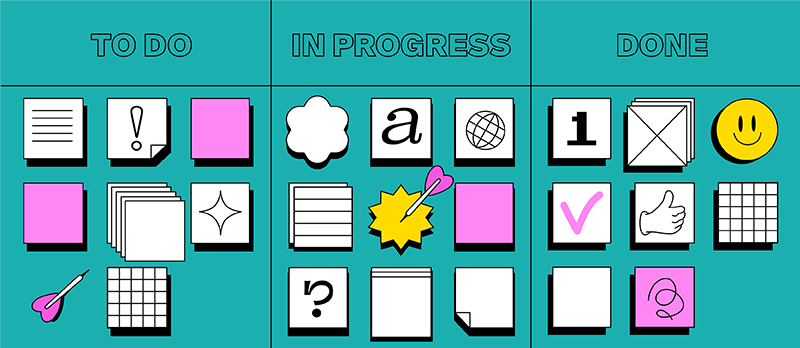How to manage marketing for a startup

Little time, little budgets, few products. A startup differs from a large established company in that any mistake can be critical, and there are few people to test ideas and theories. The development of a startup depends not only on the quality of the product or idea, but also on marketing management: no matter how cool the product is, if no one finds out about it, they won’t buy it.
Managing marketing in such conditions is not easy, but this article will help to sort out the chaos.
Small budgets
Marketing management in a startup with a limited budget is a difficult but doable task.
It is important to track the results of campaigns on the go and immediately cut off everything that does not work, so as not to waste time, budget and potential customers. Kanban, a management technique based on cards and their movement between columns, is suitable for working in such a flexible mode. The MOGU task tracker is based on this technique, a service that allows you to create a board with columns (they are usually called by the stages of task readiness – in operation, checking and ready, but everyone can customize for themselves).
Task cards are added to the columns (for yourself and colleagues), and then they move through the columns. The main goals are to visualize tasks so as not to forget anything, and to establish interaction. When the task is visible to all colleagues, it is easier not to lose it. You can immediately assign a responsible person to the tasks, set deadlines and write details and edits in the comments so that nothing gets lost.
Due to the fact that new tasks (cards) can be started at any time, flexibility is achieved, which helps to navigate processes faster — and here it is speed that is important. The less time and money you spend on broken ads, the more you spend on something that really works.
For example, we have launched a service that helps you set up autoposting on social networks. To talk about it, we need to simultaneously work on four channels — VKontakte, direct, tiktok and telegram. They have different messages, formats and budgets, from production to the cost of a single publication.
At the same time, it is necessary to maintain a single message in order not to create confusion, monitor the results, be able to compare them and understand which channel is best suited.
Without the tracker, half of the tasks would either be lost or stretched out for months. A separate feature is that if the deadline is coming soon, the date on the card is highlighted in yellow, passed in red. We did it ahead of schedule here, but it’s still convenient — it’s always clear who to write to or call with the question “how’s it going?”.
The “didn’t work” column deserves a separate love and hate — it contains ideas that turned out to be ineffective. But we try to be optimistic and remember that experience is the sum of our mistakes, and a bad result is also a result. The main thing is that we immediately realized that the article or video was not working and stopped investing the budget in their promotion.
A fickle team
The main component of marketing is your team. Often a startup does not have a permanent staff, so the team consists of remote workers and freelancers. In addition to the obvious — potentially unsuitable candidates and staff turnover, this creates unexpected difficulties.
The discrepancy in time zones makes calls more difficult, the inability to meet in person makes it difficult to establish contact, and the lack of classic conversations at the cooler does not contribute to mutual understanding.
The peculiarity of a distributed team is that many freelancers work on projects. Today they are with you, tomorrow the project is over and you don’t owe anything anymore. In order not to lose sources, videos and other data, get into the habit of adding everything to the task tracker. MOGU offers 30 GB of storage, which is enough not only for documents, but also for sources, texts and videos.
Even if your startup has a marketer, he needs to work with a team of designers, copywriters and analysts. Read more about how to organize the work of a remote team here, in short — you need to arrange regular phone calls, compare goals and do not forget to conduct kanban with all tasks.
There you can easily communicate with team members and keep them informed of the current tasks and requirements of the project. You can attach comments and files to tasks, which simplifies coordination.
Another feature is the ability to set clear deadlines. Each team member sees when a task needs to be completed and can organize their work accordingly.
Colored labels (yellow for texts, purple for videos, blue for Facebook posts) and deadlines help on the board. If you need to find something specific or sort by urgency, you can switch the board to table mode and navigate by it.
Constant analytics
You need to analyze the results of campaigns all the time — keep records of changes with dates and deadlines for checking the results. Arrange regular phone calls, check the status of tasks and the presence of problems. Even the best text cannot always convey the important details of the task. After the meetings, do not forget to write down all the arrangements. The first rule of teamwork is if it’s not written down, it didn’t happen. Templates help with the mass setting of tasks (for example, texts). We immediately mark the date of publication and important features in the text cards that help the analyst and copywriter navigate.
Even if you have a regular analyst, keep the tasks in the tracker. This way they won’t get lost, and the whole team will have access to the results (if you add them to the board).
MOGU allows you to create tasks for each team member and assign those responsible. You can set deadlines for completing tasks and track their status in real time. This will allow you to effectively plan and manage the implementation of marketing projects.


